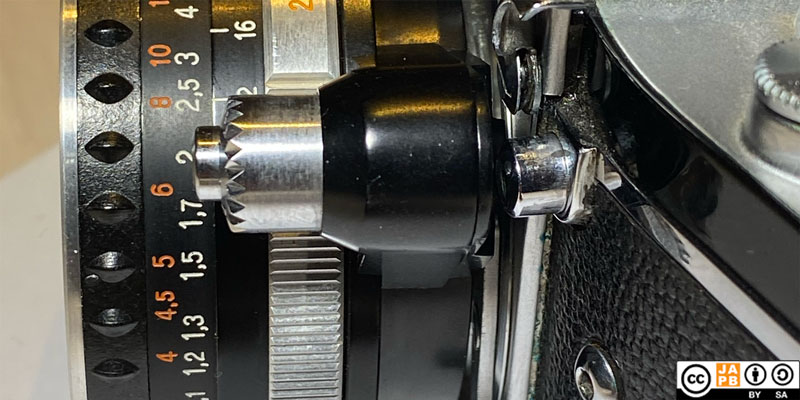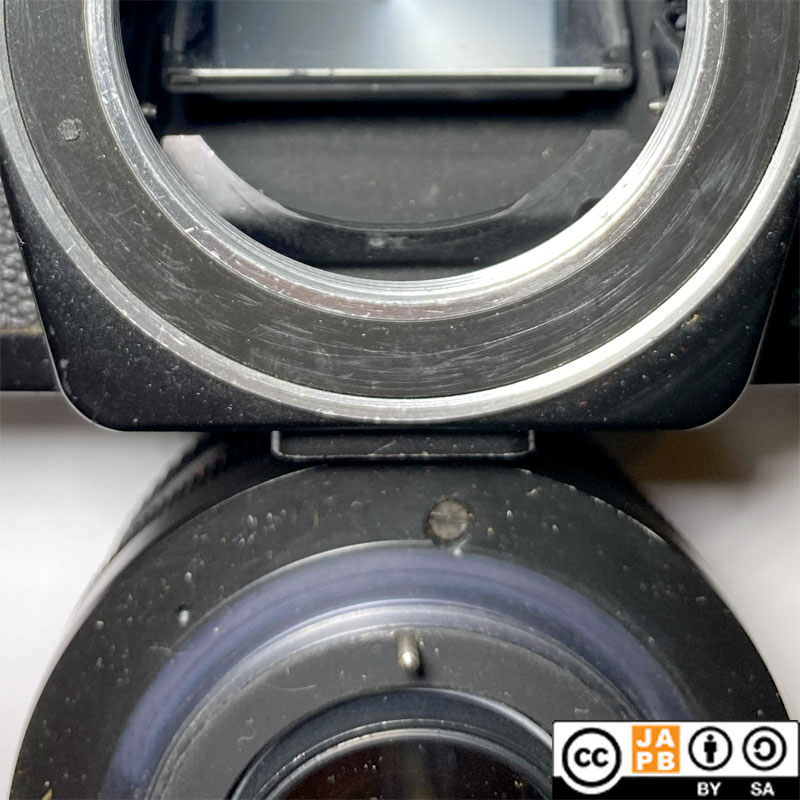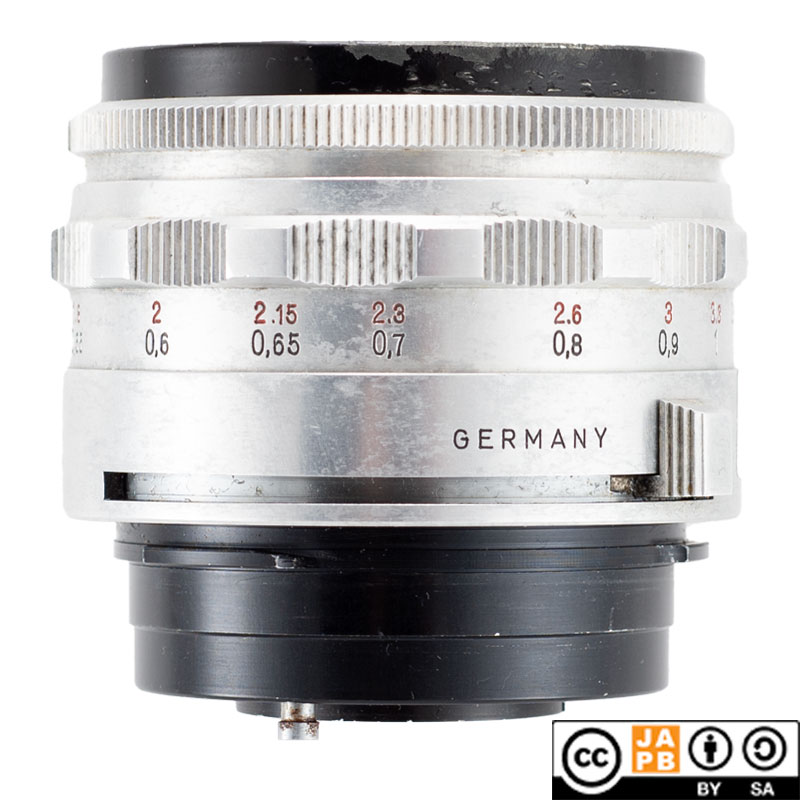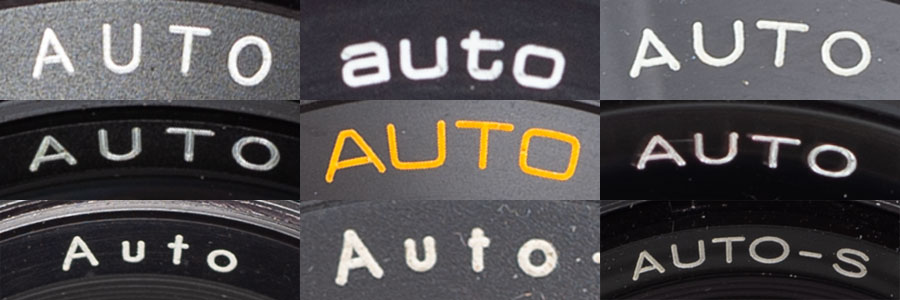Pekka Buttler, August 2025
The SLR camera was pretty much invented in the mid 1930s – shortly prior to all hell breaking loose, camera companies becoming defence contractors and a general impoverishment of (the surviving part of) humanity. After half a dozen years of collective insanity, camera and lens manufacturers went back and tried to find those plans and product roadmaps that they had developed before the war, while coming to terms with bombed-out factories, maimed workforces and an impoverished clientele.

About those roadmaps: Ever since the 1936 introduction of the Kine Exakta – the camera largely credited for having launched the concept of the SLR camera – there had been a list of mechanical wrinkles to smooth out in order to make photography easier to adopt, taking pictures more simple, improving keeper rates and – altogether – show the rangefinder camera that there was a new Sheriff in town.
The absolute top five of that list of wrinkles was:
• Figure out how to allow eye-level focusing and composition
• Find some way to allow wide-angle lenses on SLRs
• Figure out how to make the mirror return down after taking a picture
• Do away with separate dials for fast and slow shutter speeds
• Somehow automate the whole compose and focus wide open–stop down to shoot–open back up for next frame thingy.
As camera companies returned to what they really wanted to do (not make bombsights or periscopes) they started to methodically attack each of these wrinkles in turn.
The pentaprism was first introduced 1948 on the Italian Rectaflex SLR and shortly thereafter on the VEB Zeiss Ikon Contax S SLR in 1949. The pentaprism allowed eye-level focusing and did so while at the same time showing the picture as it would be (not reversed) and was adopted throughout the industry in under a decade.
The retrofocus designs for wide-angle lenses was invented in the closing days of the 1940s and became the standard way of allowing 35 mm and wider lenses on SLRs. By the end of the 1950s the industry had already reached 24 mm wide-angles and was at the cusp of a rectilinear 20 mm focal length lens.
The auto-return mirror may have been lacking from the 1936 Kine Exakta, but already in 1939 the Praktiflex (by Kamera-Werkstätten Charles A Noble) had an auto-return mirror. Then again, as that technological marvel was quickly overshadowed by the second World-Cluster**** that started mere months later, it is marginally excusable that this innovation was forgotten to such a degree that many claimed for decades that the functionality was first implemented in the Asahiflex IIb of 19541.
The unified shutter speed dial turned out a bit tricky (because slow and fast shutter speeds were governed very differently), but by the end of the 1950s this started to be available on most high-end cameras.
As an intermediate summary, we can say that two decades after the Kine Exakta had been launched:
• pentaprism ✅
• retrofocus lenses ✅
• auto-return mirror ✅
• unified shutter speed dial ✅
And all this while >90% percent of the world’s camera manufacturers just recently having been on the receiving end of the biggest bombing campaign ever.
How about that automating the aperture thingy? Now, well …
Why aperture automation was trickier than one might (today) think…
To reiterate the basic challenge: On an SLR camera the photographer is looking through the lens to compose and focus and while there are some mighty advantages with this, it also means that lenses needed to be set at their maximum aperture for focusing and composing (otherwise you would be peering into seeming darkness). At the same time the aperture needs to be set to a desired value by the time the mirror rises and the shutter curtains start moving.
Auto-aperture deliverables:
Deliverable 1: The lens must remain wide open for as long as possible, from where it must stop down to whatever value the photographers has desired in time for when the mirror starts moving and the shutter starts … shuttering.
Deliverables 2: So that the photographer would not need to manually open up the aperture again, the lens should then preferably be opened back up again.
Lenses that manage deliverables 1 and 2 are (fully) automatic aperture lenses.
Lenses that offer deliverables 1 (but not 2) are semi-automatic aperture lenses.
Lenses that deliver 2 (but not 1) are a study in mistaken priorities.
Fundamentally there is no real magic involved in aperture automation. Even so there were two key challenges: Power and coupling.
Power. “Automation” today means a battery and some electronics or mechatronics, but in the 1950s cameras did not yet use batteries. Instead, if you needed to store force in a camera you put in a spring and some way to tension that spring2. As the list of mechanical work that would be expected of a camera whenever a photographer jerked their index finger grew and grew3, this unavoidably meant that more force needed to be stored inside the camera. The first challenge therefore was to a) generate and store more force inside the camera (which either meant more aggressive gearing or more lever/knob motion; b) make everything run smoothly, and c) make sure that all the things are reliably done with correct, tight timings. In terms of implementation, that last turned out to be crucial, because if aperture automation produced a noticeable increase in shutter lag, that would have been unacceptable.
Coupling. Auto aperture necessitates that there is some way for the lens to be stopped down right before the shutter is actuated (and for the lens to open back up again once the shutter has closed).
Today (and for more than the last 60 years) the preferred method is for there to be a pin or lever inside the lens mount that the camera activates before starting the whole mirror-shutter-mirror rigmarole, but back in the 1950s there was another way.
PADs/pods
The Exakta camera had its shutter button next to the lens mount on the front left (from the photographer’s angle). This was close enough to the mount4, that if the lens was fitted with a contraption that would reach over and cover that shutter button, that contraption could be the first to notice that a photographer was starting to press the shutter button. That contraption would then first stop down the lens, before allowing the pressure to reach the shutter activation button.
In effect, the photographer would press the aperture stop-down button on a lens, the lens would stop down, and if the photographer would go on pressing, the shutter would activate. This was genius, especially in its ability to circumvent the “how do we find room inside the rather cramped Exakta mount for a camera-to-lens stop-down system?5“

These pass through contraptions are not just called contraptions, they are officially referred to as Pressure-activated diaphragm (or PAD for short) and colloquially known as ‘pods’ due to their shape and looking like weird appendages/outgrowths of lenses. These PADs/pods started appearing on Exakta lenses in around 1954 (the earliest serial numbers I’ve seen are around 3,8 million), but they were initially significantly more expensive than preset lenses and became commonplace only in the 1960s
The exact PAD/pod above is a Carl Zeiss Jena design, and every lens manufacturer that was serious in making lenses for the Exakta system (which until the late 50s was still the world’s undisputed number one SLR system) devised their own distinct (but sometimes very similar) contraption to facilitate the same.
Moreover, after having seen the ease by which the Exakta system morphed from a clunky “manual and preset lenses” system into the world’s most ambitious auto aperture system, there were some other manufacturers that wanted to adopt this recipe, most prominently the Miranda camera company and Tokyo Kogaku (Topcon) who both designed front-shutter cameras in the late 1950s to use pass-though contraptions very similar to the Exakta PADs/pods.
Here comes the pin
The competition – both in Germany and in Japan – observed with envy the relative easy by which the Exakta had taken what was essentially a dumb brick of a camera and had added a bunch of automation to it. Moreover, the Exakta PAD’s modus operandi virtually guaranteed that the lens was stopped down before shutter actuation and did so by utilising the time it took the shutter finger to move from ‘resting lightly on the shutter’ to ‘now is the moment i want to capture’.
But many of the competitors who had already launched SLRs (Asahi, KW, Wirgin) were working with the M42 thread mount, and as one potential issue with thread mounts versus bayonet mounts was that it was not as foolproof in terms of always threading in all the way6 (resulting in a lens that was rotated a few degrees beyond or short of where it was assumed to be). In short, even if these camera manufacturers had started introducing cameras with shutter buttons on he front text to the mount, the basic nature of the M42 mount would have conspired to virtually guarantee that not all PADs/pods would come to rest on the shutter buttons. A better solution was needed.
While the M42 lens mount did not sport especially generous dimensions (nothing like the contemporary Rectaflex mount), it did leave enough space (especially at the top and bottom) for adding some interface/control elements inside the mount without those coming into conflict with the light that would end up on the film. As placing any such interface elements at the top would have caused collisions with the mirror, the bottom of the M42 mount was the obvious position. Also, because of the angular uncertainty inherent in the M42 mount, a lever that would move sideways was a risky option. Instead, industry arrived at7 a simple pin, that would be depressed (for stop-down) by a decidedly oversized paddle (oversized to overcome that angular uncertainty).

While the M42 is far from the only mount to use a pin (by which JAPB means a control element that moves in/out, not sideways), pins as controls for auto aperture are in the minority. Even so, even here there are some differences in operating logic.
Another very early attempt at aperture automation was the Praktina mount, which started implementing semi-automatic aperture lenses around 1953. Also Praktina lenses used a pin mounted inside of the bayonet to activate shutter stop down. Initially the Praktina system only offered semi-automatic lenses, meaning stop-down would be automatic, but thereafter the user would need to manually prime the lens for another stop-down. In these semi-automatic Praktina lenses merely touching the pin would trigger the stop-down (with a rather satisfying ‘snap’).

Subsequently, The Praktina system would move from semi-automatic aperture to fully automatic aperture. However, there is a noteworthy aspect to this. While the Praktina system retained the pin as stop-down control (being a breech-lock mount, they had other options), they now turned its functionality entirely on its head. Instead of being a “press pin in to stop down” approach, it now was a “press pin down to open up” approach.

Let me return to the issue of power mentioned earlier. In the M42 auto lenses, there is a spring in every lens somewhere close to the aperture mechanism. That spring’s job is to constantly try to pull the aperture open. At taking-the-shot time, it is the camera’s job to move that oversized paddle (pictured earlier) with such a force that it overpowers the spring within the lens as well as any frictions that may be in the system. When that paddle slams into the stop-down pin, the aperture is stopped down as far as the aperture ring allows it to go. Once the camera feels it no longer needs to keep the aperture closed down, it withdraws the paddle and the spring inside the lens can pull the aperture back open again.
In the Praktina automatic lenses there is a spring within the lens that constantly tries to pull the aperture closed. When the lens is just sitting around without cameras or lens caps, the aperture is closed down to whatever value the aperture ring says. When you mount the Praktina auto lens on a compatible Praktina body (a Praktina IIA, to be exact), the camera has a lever within the mount that will depress the pin, hence forcing the aperture to open wide. When the photographer presses the shutter button, that lever retracts, allowing spring within the lens to pull the aperture closed, only for that lever to return and open the lens back up again after the photo is taken.
And here – about 10 minutes into this article – we finally get to what the title already alluded to: A fundamental difference between all existing (mechanical) auto aperture systems is whether it the camera’s role to
A) overpower the spring inside a lens (that tries to keep the aperture open) to force the lens to stop down (as far as the aperture ring allows) at picture-taking time or
B) release the spring inside a lens (that tries to pull the aperture closed) to allow the lens to stop down (as far as the aperture ring allows) just before the curtain opens…?
Tomato tomato; aluminum aluminium …?
What does that matter – you may say. The only real difference – you might point out – is whether the camera overpowers the lens before or after taking the picture. And you would be quite right in that.
With ‘Push to stop down’ (P2SD) lenses the overpowering happens before the shot (and after the shot has been taken the aperture is released to open back up again) – with ‘release to stop down’ (R2SD) lenses the releasing happens before the shot, while the overpowering happens after the shot. But in several ways that is a crucial difference.
Consider what happens if a lens has oil on the aperture blades, leading to that the aperture blades move a bit sluggishly. On a ‘push to stop down’ lens the aperture might offer a bit more resistance, but as such a camera must rely on using a lot of force to stop down the lens, this will likely not make much of a difference and the lens will stop down to the predetermined aperture value in time for when the shutter does its thing. On a ‘release to stop down’ lens this is a crucial difference as sluggish aperture blades means that the diaphragm will only be half-way there by the time the shutter takes the shot, leading to constant overexposures.
On the other hand, if we assume the aperture mechanism of a lens is jammed – either due to tried gunk on the blades or thanks to a mechanical obstruction, the ‘release to stop down’ approach will be safer, as while it will leave the aperture wide open, it does not risk injury to either the lens or the camera (which might happen on a ‘push to stop down’ camera).
Implications for adapting
Finally, there are further implications for the core audience of this blog – people who want to use lenses on cameras they were not originally intended for, especially mirrorless digital cameras.
A ‘release to stop down’ lens will always (when not mounted on an adapter or camera) be at the aperture its aperture ring is set to. This means that if you want to pop it in an adapter, its aperture ring will work without the adapter needing in any way to interact with the aperture stop-down mechanism on the lens. Some examples of (legacy-age) lens mounts that use this approach are Konica AR, Minolta SR, Nikon F and Pentax K (and many others).
A ‘push to stop down’ lens will only ever stop down if force is applied in practice this means that unless it is commanded to stop down by the camera or an adapter, it will permanently remain wide open. Some examples of these types of lens mounts: Canon FL and Canon FD, Fujica X, M42 (auto), Olympus OM. Very often such lenses will need an adapter that has a control ring that enables the lens to stop down (e.g. Canon FL/FD, Fujica X, while sometimes lens adapters can be manufactured in such a way that they always stop down the lens as far as the aperture ring allows (e.g. M42 adapters with internal flange, Olympus OM).
Footnotes
- Anyone who wants to contend that the Praktiflex’ mirror was not a *real* instant return mirror because you had to raise your finger from the shutter for the mirror to return is free to show me those scores of photographers who regularly lean on their shutter button for minutes after taking each shot. ↩︎
- Remember, this is the era when if you wanted a motor drive (or a camera that could do continuous mode) also that was done through tensioned springs. For some (in today’s perspective) ludicrously steampunk-implementations see the Robot camera or the Praktina spring winder ↩︎
- From the 1936 minimum: Raise mirror, actuate shutter curtain to the mid 50s de rigeur: move frame counter, stop down lens, raise mirror, actuate shutter curtain, lower mirror, open lens back up again ↩︎
- While I have heard speculation that this affordance was intentionally designed into the 1936 Kine Exakta, I have found no primary sources to support such claims. Also, I have my reasons to doubt them. ↩︎
- Incidentally, The Exakta RTL1000 offered one answer to this question in the late 1960s, and while technologically successful, it was an economical flop. ↩︎
- Exacerbated by that some actors seemingly already had decided that they wanted their M42 lenses to stop at a slightly different rotation. ↩︎
- When I say ‘industry arrived at’ I mean to say that I have no idea whether this happened by common design, happenstance or just simply copying the first mover. ↩︎
